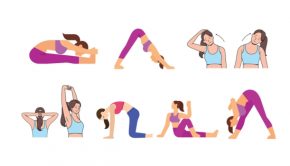Fitness à la Carte ~ The Latest, Hottest Trends
This year, many Americans are set to rock the charts by turning over a new leaf and morphing from more conventional workout modes to fresh takes on fitness.
Chart Toppers
Activities high on people’s lists these days reflect a perceived scarcity of time and money. The top picks, according to the Indianapolis-based American College of Sports Medicine (ACSM) Worldwide Survey of Fitness Trends for 2014, will be high-intensity interval training (HIIT) and body weight training.
Both pursuits have been contenders in recent years, but are cresting the survey for the first time. A HIIT session, typically involving rapid bursts of activity interspersed with brief rest periods, usually takes less than 30 minutes. Body weight training’s appeal stems from its effectiveness and minimal need for fancy equipment or special gear.
The survey—involving hundreds of personal trainers, gym owners and other fitness insiders—further notes an increasing diversity in fitness offerings, plus some contradictory trends. Not everyone, for instance, is cost-conscious; fitness professionals anticipate the continued rise of boutiques specializing in niche activities. Those with momentum range from ballet-inspired barre workouts to Pound and Drums Alive sessions, in which people “rock out” while they work out.
Grace DeSimone, an ACSM spokesperson, equates specialized offerings to an à la carte menu, with individuals choosing tasty workout modes. “It’s like a buffet,” she says. While a single class can cost up to $25, there seldom are membership fees. Muscles are treated to varied workouts, even if only once a week in a “boutique” treatment.
“It’s good for your body to cross-train; if you do the same thing over and over again, your body adapts,” DeSimone advises. Unless a competitive athlete is looking to improve performances in a given sport, repeating the same exercise daily can lead to injury and lessen the desired positive impact, she says. “Your body likes change.”
Spinning spin-offs like Soulcycle, Flywheel and Kinetic Cycling represent an evolution of indoor classes and old-school outdoor cycling. Meanwhile, fitness instructors and wellness consultants note that Zumba has set the stage for dance-oriented workouts, diverging from Latin rhythms into hip-hop and other music genres.
If workouts are increasingly encroaching on “social” activities like dancing, it’s because the nation—or at least the expanding population trying to live healthier lifestyles—is undergoing a broader lifestyle transformation, says Jim White, of Virginia Beach, Virginia. The registered dietitian, award-winning fitness pro and national spokesman for the Academy of Nutrition and Dietetics observes, “There’s a shift in culture.”
He says, “People are sick of ‘yo-yo-ing’ with fad diets and exercise routines, and they are looking for effective new approaches, whether for dieting, social life, accountability or competition.” He sees this new mindset fueling the proliferation of websites and phone apps that facilitate everything from counting calories and steps walked daily to on-the-go workouts.
What’s Playing
Interval Training: Both high- and low-intensity variations can resemble a fountain of youth for older adults, says DeSimone. These can range from integrating a few five-minute sprints to enhance a half-hour walk to engaging in formalized Asian-influenced Tabata classes and boot camps.
High-intensity workouts aren’t for everyone. “HIIT is best delivered when it does not use the one-size-fits-all approach,” says Tony Ordas, a kinesiology lecturer at California State University,
San Marcos. “Participants need to have an established level of cardiovascular endurance before increasing intensity.”
Body Weight Training: The natural, timeless exercise approach of using our own body weight instead of equipment can, if done right, hone muscles and build core strength, often in creative ways.
Personal Training, Small-Group Training and Wellness Coaching: Rising demand by individuals for support in achieving their desired results is propelling growing numbers of trainers and coaches to obtain health and fitness college degrees and postgraduate certifications.
Specialized Fitness Programs: Programs geared to the needs of particular groups such as pregnant women, older adults, dog owners and those interested in losing weight remain popular. Activities vary in approach and intensity, but often emphasize “functional fitness”, focusing on building strength and balance useful in everyday life, rather than more athletic or competitive training.
Yoga: This ancient mind-body workout continues to extend from East to West, building on a host of classical forms such as hatha, ashtanga, kripalu, kundalini and Vinyasa. Relatively new forms also are extensive, from power yoga, Bikram and Yogalates to emerging hybrids like the yoga/surfing combination of Yoga Board.
Christine MacDonald is a freelance journalist in Washington, D.C., whose specialties include health and science. Visit ChristineMacDonald.info.





























